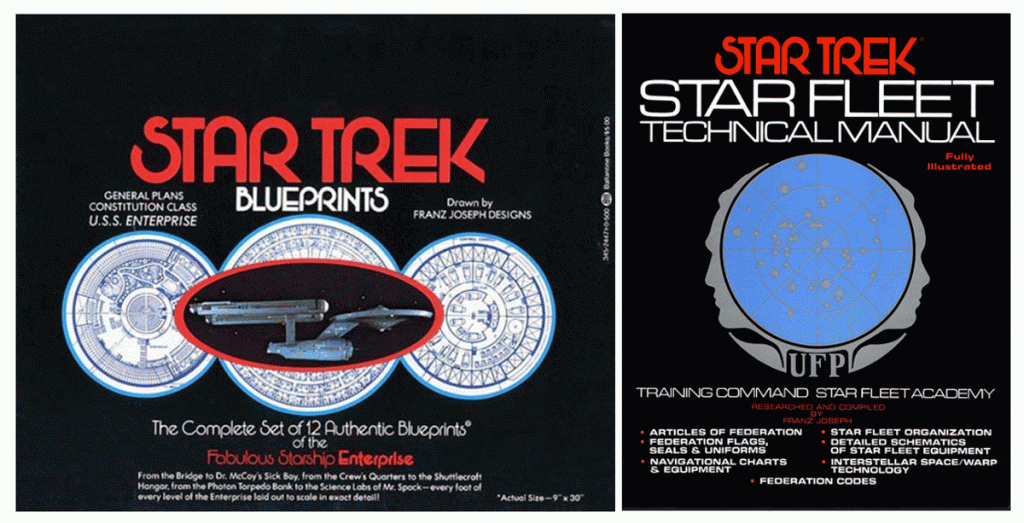Back in the '70s when FJ's work went mainstream it was an eye opening experience for me and a lot of like minded fans. He brought an added dimension and depth to the "universe" that we glimpsed on Star Trek. I don't think much if anything before (in genre materiel tie-ins) had been done near the level of what FJ had done. Mind you, the fans themselves might have already gotten started before FJ, spurred by the basic schematics, and the accompanying text describing the layout of the ship's interior, found in the pages of The Making Of Star Trek. I know I got started that way. But probably like many others discovering FJ's work really fanned the fire of enthusiasm.
For a lot of fans his work became accepted as almost gospel to the point that some can't bear any criticism of his work, as if there is no middle ground---either accepted in whole or not at all. It can make for lively discussions.
One undeniable effect of FJ's work was in how it inspired countless fans to expand, build on and in some cases correct what he started. He also had an affect on the field of popular entertainment in film and television in fostering a market that really didn't exist before. After FJ's Booklet Of General Plans and the Star Fleet Technical Manual we began to see material from other popular films and television series. And this went on for decades.
The publishing industry might be receding from this kind of materiel in recent years, but it shows no sign of slowing down with the fans themselves. In the beginning they grabbed pencil and paper and with varying degrees of proficiency churned out reams of new ship designs and uniforms and hardware. And with the advent of the internet it's just grown particularly with the accessibility of 3D modelling programs. It's huge and being able to share work online the fans really don't need the publishers anymore and haven't for years. The sole value of a published hardcopy work is in seeming to lend the materiel a sense of legitimacy. But in dealing with totally fictional materiel that seems to be largely unimportant.
Even when FJ's work was new it wasn't above criticism. Perceptive fans soon began to note where FJ was apparently inconsistent with what could be seen on television. That can't be argued. But equally it can't be argued that he inspired legions of devoted fans and even an entertainment industry to follow and build on what he'd started.
For a lot of fans his work became accepted as almost gospel to the point that some can't bear any criticism of his work, as if there is no middle ground---either accepted in whole or not at all. It can make for lively discussions.
One undeniable effect of FJ's work was in how it inspired countless fans to expand, build on and in some cases correct what he started. He also had an affect on the field of popular entertainment in film and television in fostering a market that really didn't exist before. After FJ's Booklet Of General Plans and the Star Fleet Technical Manual we began to see material from other popular films and television series. And this went on for decades.
The publishing industry might be receding from this kind of materiel in recent years, but it shows no sign of slowing down with the fans themselves. In the beginning they grabbed pencil and paper and with varying degrees of proficiency churned out reams of new ship designs and uniforms and hardware. And with the advent of the internet it's just grown particularly with the accessibility of 3D modelling programs. It's huge and being able to share work online the fans really don't need the publishers anymore and haven't for years. The sole value of a published hardcopy work is in seeming to lend the materiel a sense of legitimacy. But in dealing with totally fictional materiel that seems to be largely unimportant.
Even when FJ's work was new it wasn't above criticism. Perceptive fans soon began to note where FJ was apparently inconsistent with what could be seen on television. That can't be argued. But equally it can't be argued that he inspired legions of devoted fans and even an entertainment industry to follow and build on what he'd started.
Last edited:


 ).
). ) I’m taking these issues into account and I get to hear my approach is “radical”, while I’m just trying to be accurate and onscreen-compatible. That tells me a thing or two how good or bad the influence of the works of Franz Joseph is up until this day.
) I’m taking these issues into account and I get to hear my approach is “radical”, while I’m just trying to be accurate and onscreen-compatible. That tells me a thing or two how good or bad the influence of the works of Franz Joseph is up until this day.
 Rather looks to me that both Franz Joseph and Paramount should have paid royalties to the United Nations, which served as an inspiration for both.
Rather looks to me that both Franz Joseph and Paramount should have paid royalties to the United Nations, which served as an inspiration for both.


